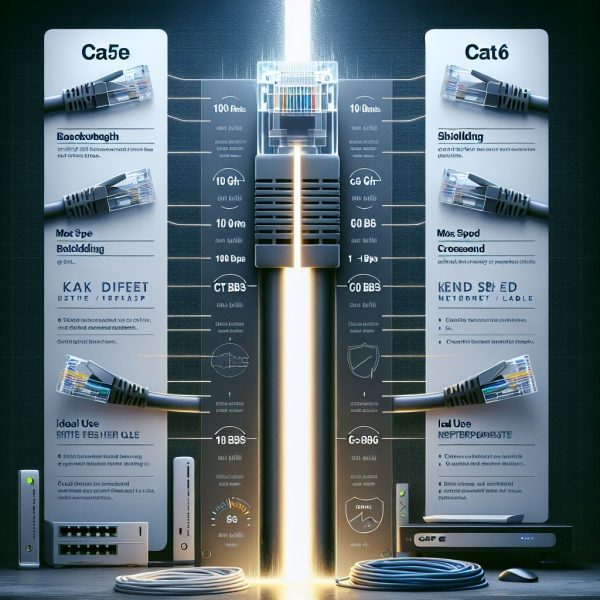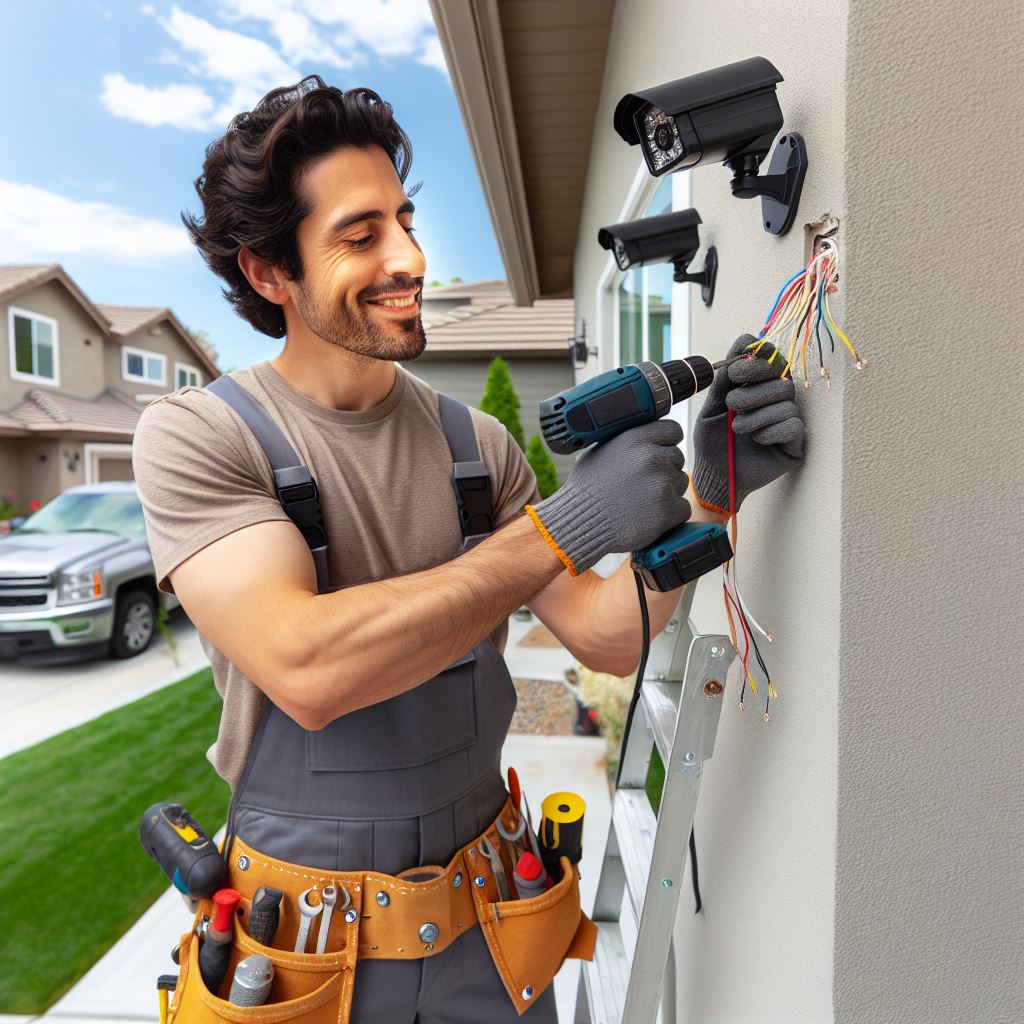In today’s digitally connected world, a reliable internet connection is more important than ever—whether you’re streaming movies, gaming online, or working from home. At the heart of that connection lies a humble but essential component: the Ethernet cable. There are many different types of Ethernet cables, but primarily for our homes and small businesses the two most commonly used types are Cat5 and Cat6 cables. While they may look nearly identical on the outside, the differences in performance, speed, and future-proofing can be significant. In this article, we’ll break down what sets Cat5 and Cat6 cables apart, and help you decide which one is right ethernet cable for your networking needs.
When comparing Cat5 and Cat6 cables, it’s important to note that Cat5 is largely considered obsolete, and the more commonly used cable type in that family is Cat5e (Category 5 enhanced). Therefore, this explanation will primarily focus on the differences between Cat5e and Cat6.
Cat5 Vs Cat6 Speed & Bandwidth
Cat5e
Speed: Cat5e ethernet cables support speeds up to 1 Gigabit per second (Gbps), also known as Gigabit Ethernet (1000BASE-T). While it can technically support 2.5GBASE-T over shorter distances, 1 Gbps is its primary rated speed at its full length of 100m.
Bandwidth: Operates at a frequency of up to 100 MHz This refers to the amount of data the cable can transmit at any given time.
Cat6
Speed: Cat 6 can support higher speeds up to 10 Gigabits per second (Gbps) (10GBASE-T). However, this 10 Gbps speed is typically limited to shorter distances, up to 55 meters (approx. 180 feet). For long runs up to its maximum permissible length (100 meters), its speed is best quoted at 1 Gbps.
Bandwidth: Operates at a higher frequency of up to 250 MHz This increased bandwidth allows higher data transfer rates by being able to process more data simultaneously compared to Cat5e.
Construction of Cat5e Compared to Cat6 and Interference Reduction.
This is where one of the big differences lie, Cat6 cables are built with stricter standards and better insulation, which allows them to handle faster speeds and reduce signal interference more effectively than Cat5e. This makes Cat6 more suitable for high-performance networks.
Twisted Pair Configuration
Both Cat5e and Cat6 network cables utilize four twisted pairs of insulated copper wires, a design that mitigates electromagnetic interference (EMI) and near-end crosstalk (NEXT). The twisting of the pairs ensures that any external electromagnetic noise affects both wires equally, allowing the differential signal to remain intact. However, while both categories use this principle, Cat6 cables are manufactured with stricter twist rate tolerances, meaning the number of twists per inch is more tightly controlled and generally higher. This results in superior noise rejection and enhanced signal integrity, particularly at higher frequencies.
Enhanced Pair Separation and Internal Spline
A main difference in the structure of Cat6 cables is the inclusion of a central spline or cross-shaped plastic separator. This spline physically isolates each of the four twisted pairs, maintaining consistent spacing and reducing alien crosstalk (AXT)—interference from adjacent cables. This is especially important in high-density installations or when cables are bundled together. The spline also helps preserve the cable’s geometry and impedance characteristics, which are critical for maintaining performance at frequencies up to 250 MHz, compared to Cat5e’s 100 MHz. Cat5e cables typically lack this internal separator, making them more susceptible to internal and external interference.
Conductor Gauge and Insulation Thickness
Cat6 cables often use 23 AWG (American Wire Gauge) copper conductors, which are slightly thicker than the 24 AWG conductors commonly found in Cat5e cables. Thicker conductors reduce DC resistance, allowing for better signal transmission over longer distances and improved power delivery in Power over Ethernet (PoE) applications. Additionally, Cat6 cables generally feature thicker individual wire insulation and a more robust outer jacket, which not only enhances durability but also contributes to better attenuation performance—the reduction of signal strength over distance.
Shielding and Electromagnetic Protection
While both Cat5e and Cat6 cables are available in UTP (Unshielded Twisted Pair) and STP (Shielded Twisted Pair) variants, shielding is more prevalent and often more effective in Cat6 cables. Cat6 STP cables may include individual foil shields around each twisted pair, a braided overall shield, or both. These shielding layers provide an additional barrier against radio frequency interference (RFI) and electromagnetic interference (EMI), which is particularly beneficial in electrically noisy environments such as industrial settings or near heavy machinery. Cat5e cables, especially in consumer-grade applications, are more commonly unshielded and thus less resistant to such interference.
Cat5e Versus Cat6 Comparison Table
| Specification | Cat5e | Cat6 |
|---|---|---|
| Maximum Bandwidth | Up to 100 MHz | Up to 250 MHz |
| Maximum Speed | 1 Gbps | 10 Gbps (up to 55 meters), 1 Gbps (up to 100 meters) |
| Frequency | 100 MHz | 250 MHz |
| Shielding | UTP or STP | UTP or STP, often with a central spline |
| Construction Features | Twisted pair cables, typically 24 AWG conductors | Tighter twists, thicker insulation, often 23 AWG copper wire conductors, central spline |
| Maximum Length | 100 meters (328 feet) | 100 meters for 1 Gbps, 55 meters for 10 Gbps |
| Use Cases | Home networks, small office networks, standard internet usage | High-speed LANs, enterprise networks, data centers, future-proof installations |
| Cost | Lower cost, typically less expensive than Cat6 | Higher cost, typically 10–20% more expensive than Cat5e |
Cat 5e V’s Cat6 – Crosstalk and Signal Integrity
In Ethernet cables, multiple pairs of wires are bundled closely together. When an electrical signal travels through one pair wires, it generates an electromagnetic field. If the cable isn’t properly designed or shielded, this field can couple into adjacent wire pairs, causing interference. This is known as crosstalk.
Cat5e (Category 5 Enhanced) was developed to improve upon the original Cat5 standard by introducing tighter specifications for Near-End Crosstalk (NEXT) and Return Loss. While it effectively reduces internal interference compared to its predecessor, Cat5e is still limited in its ability to suppress crosstalk at higher transmission frequencies. It supports bandwidths up to 100 MHz, which is sufficient for Gigabit Ethernet (1000BASE-T) over distances up to 100 meters. However, as frequency increases, the cable’s ability to maintain signal integrity diminishes due to its relatively looser twist rates and lack of internal pair separation.
The key difference is that Cat6 (Category 6) is engineered with significantly enhanced electrical performance characteristics. It features tighter twist rates, more consistent pair spacing, and often includes a central spline (cross-divider) that physically separates the twisted pairs. These design improvements lower interference and result in substantially lower levels of NEXT and ELFEXT (Equal-Level Far-End Crosstalk) thereby creating fewer errors. Cat6 cables are rated for frequencies up to 250 MHz, enabling them to support 10 Gigabit Ethernet (10GBASE-T) over shorter distances (up to 55 meters in typical environments).
The stricter crosstalk specifications in Cat6 translate to:
- Improved signal-to-noise ratio (SNR)
- Reduced bit error rates (BER)
- Greater immunity to alien crosstalk (AXT)
- More reliable high-speed data transmission
These enhancements make Cat6 a more robust choice for modern high-performance networks, particularly in environments with dense cabling or high electromagnetic interference.
Cat5e Vs Cat6 Maximum Cable Length
Cat5e and Cat6: The 100-Meter Standard Length
Both Cat5e and Cat6 Ethernet cables adhere to the TIA/EIA-568 standard, which specifies a maximum channel length of 100 meters (328 feet) for structured cabling in Ethernet networks. This length includes:
- 90 meters of solid horizontal cabling (in-wall or in-ceiling)
- 10 meters of stranded patch cables (typically at each end)
This 100-meter limit is based on the cable’s ability to maintain acceptable levels of attenuation, crosstalk, and signal-to-noise ratio (SNR) to support Gigabit Ethernet (1000BASE-T) with minimal packet loss or retransmission.
Cat6: 10 Gbps Performance and Distance Limitations
While Cat6 cables are rated to support higher bandwidth speed up to 10 Gigabit Ethernet (10GBASE-T), this performance is only guaranteed up to 55 meters (180 feet) in environments with typical levels of alien crosstalk and electromagnetic interference (EMI). This limitation is due to the increased signal frequency required for 10 Gbps transmission—up to 250 MHz—which makes the cable more susceptible to:
- Insertion loss (signal weakening over distance)
- Return loss (reflected signals due to impedance mismatches)
- Alien crosstalk (interference from adjacent cables)
Beyond 55 meters, the bit error rate (BER) increases significantly, and the cable may fall back to 1 Gbps operation to maintain link stability.
Cat5 Versus Cat6 Costs
Cat6 cables typically command a higher price point than Cat5e cables—the cost difference is typically 10–20% per unit length. This cost differential is attributed to the more rigorous manufacturing standards, the use of higher-grade materials, and the frequent inclusion of a central spline designed to enhance performance by reducing crosstalk and maintaining cable geometry.
Cat5 – Cat 6 Backward Compatibility
One of the key advantages of Cat6 Ethernet cables is their full backward compatibility with earlier cable standards, including Cat5e, Cat5, and even Cat3. This means that Cat6 cables can be seamlessly integrated into existing network infrastructures that utilize older hardware, such as routers, switches, or patch panels designed for lower-category cables.
However, it is important to note that while the physical connection will function correctly, the overall network performance will be constrained by the lowest category component in the link. For example, if a Cat6 cable is connected to a device rated for Cat5e, the maximum achievable data rate will be limited to Cat5e specifications—typically up to 1 Gbps. This compatibility ensures flexibility in upgrades and gradual transitions to higher-performance networking without requiring immediate replacement of all existing equipment.
What applications dictate the use of Ca5 or Cat 6 ?
Applications for Cat5e –
- Home and small office networks with typical internet speeds and standard network equipment (e.g., maximum speeds up to 1 Gbps).
- Adequate for activities like online gaming, HD video streaming, and general web Browse at gigabit speeds.
- Cost-effective and easy to install.
Applications for Cat6 –
- Larger networks, businesses, and data centres where better performance will benefit increased productivity. Cat6 will provide a higher bandwidth speeds, especially over shorter runs where you can run 10-gigabit ethernet.
- Businesses and Offices with a high-speed internet connection may find a higher performance from Cat6.
- High-bandwidth applications that demand consistent and reliable data transmission. such as network-attached storage (NAS) systems, IP surveillance networks, and installations where electromagnetic interference (EMI) may be present. Their enhanced shielding and performance specifications make them ideal for scenarios involving substantial data throughput and minimal tolerance for signal degradation.
- Networks that require future-proofing. While 10 Gbps isn’t yet universal for many home or SMB users, having Cat6 in place allows you to upgrade your network infrastructure without re-cabling.
Conclusion: Cat6 vs. Cat5e – A Forward-Looking Perspective
In summary, Category 6 (Cat6) cabling represents a clear advancement over Category 5e (Cat5e) in terms of electrical performance, network speed, bandwidth capacity, and resistance to interference. With support for higher frequencies (up to 250 MHz) and enhanced construction features—such as tighter twist rates, improved insulation, and often a central spline—Cat6 cables are engineered to deliver superior signal integrity and reduced crosstalk, particularly in high-speed or high-interference environments.
While Cat5e remains a reliable and cost-effective solution for many current applications, including standard home networking and small office setups, it is inherently limited to Gigabit Ethernet (1 Gbps) and lower frequency operation. In contrast, Cat6 is capable of supporting 10 Gigabit Ethernet (10GBASE-T) over shorter distances, making it a more suitable choice for future-proofing network infrastructure and accommodating bandwidth-intensive applications such as media streaming, large file transfers, and enterprise-level data services.
Ultimately, the best choice of cabling system should be guided by both current performance needs and anticipated future demands. For users seeking long-term scalability, enhanced reliability, and greater resilience to signal degradation, the best type of cable would be Cat6, it offers a better choice and future-ready networking solution.



